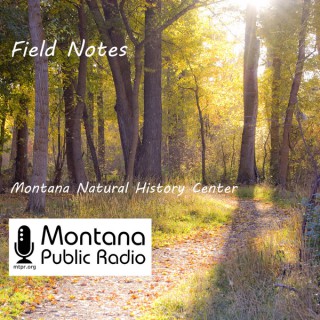Field Notes from the Montana Natural History Center
Follow Field Notes from the Montana Natural History CenterNature notes and inquiry from the Montana Natural History Center.
- Nov 25, 2025 LATEST EPISODE
- every other week NEW EPISODES
- 4m AVG DURATION
- 166 EPISODES
More podcasts from Montana Public Radio
Latest episodes from Field Notes from the Montana Natural History Center

T̓at̓áyaqn (Bitterroot Salish) ventured to the plains yearly to hunt q̓ʷiq̓ʷay (bison)
Near Čmʔomʔotúlexʷ (Place of Smokey Land) or Yellowstone National Park, in -5-degree weather, I kneeled on my freshly skinned bison hide, which provided steaming warmth beneath me.

I like to talk to the crows, though I don't know what we're talking about. Researching the subject, I learned that they have over 250 different calls.

Summer brings more than blue skies and hot days to Montana. It's during this time of the year that white-tailed deer fawns are born.

It was too soon for swirls of cascading autumn leaves, and the formation of this sudden dispatch had a certain energy to it. This orange blast of color moved with purpose.

There is a pine needle on my kitchen table. There is a pine needle in my soul. If I could only put that on paper.

As the days grow shorter and nights turn cooler, I find myself drawn outdoors at sunset.

As I watched these mountain bluebirds, likely catching those pesky mosquitoes for their dinner, I felt a familiar comfort in their presence.

Fireweed's vibrant flowers provide sweet nectar to native bees, flies, butterflies, and even honeybees, if their hive is nearby.

Oak gall ink was the most popular ink in Europe from the Middle Ages to the 19th century. The Book of Kells from A.D. 800, the Magna Carta, and the Declaration of Independence were all written in gall ink.

My eyes slowly followed the tree down to the base when I saw that my dog was carefully pulling the berries right off the branches and swallowing them down.

This amazing place has seen it all, from a giant sea to volcanoes and glaciers to today's semi-arid desert.

Clueless as to what this was, I relied on a phone app for identification. Curlycup gumweed? Who came up with that creative name?

On the suggestion of an experienced birder, I bought a wire wreath and stuffed it with unshelled peanuts. The magpies spent hours skirmishing with each other to grab a peanut. I reveled in the mayhem.

There were tulip poplars, also known as yellow poplars or tulip trees. No tulip maples. I'd thought I'd seen the real thing in Washington, DC. No such beauties adorned my backyard.

Throughout history, people have been captivated by owls. There are 260 species of owls across the planet. They can be found on every continent except Antarctica.

I've always been fascinated by ruffed grouse. For such a small, skittish-seeming bird, they have a hugely outsized presence in the soundscape of the forest.

It's easy to see how the nighthawks' idiosyncrasies make them a crowd favorite, but what I love most about them are the cherished memories they resurrect.

A lone Sandhill Crane stood at the edge of the marsh feeding, its bill dipping repeatedly through the mud with a series of rapid, steady bursts reminiscent of a sewing machine's insistent motion.

Earthworms use their entire body to breathe. Burrowed deep in the ground — slow moving, slow metabolizing — their long frames tighten and relax and pull the air they need from soil.

They looked like bulging stockings decorating a mantle at Christmastime. They were certainly gifts of a sort for our winter-weary senses. These were the unique nests of Bullock's Orioles.

In the natural world, how to persist—how, even, to improve—in the face of limits and uncertainty can be a punishing question.

As I drove home from Missoula, I was alarmed to see wildfire smoke across the freeway from my house in Frenchtown. Even more concerning was the convoy of pickups pulling stock trailers.

We have three species of garter snakes in Montana. The snake couple I saw were the terrestrial species, Thamnophis elegans, who can lack the colorful markings of the other two.

In late 2020 I'm spending mornings masked, working in a lab in the University of Montana Zoological Museum. The museum houses research collections of natural artifacts like skins and skeletons. But behind the scenes museum staff tend a single living collection: a colony of dermestid beetles, the meticulous scavengers that scour flesh from bones before a skeleton can be installed in the museum.

Why are they so feared and misunderstood? If a bird popularity contest were held, Turkey Vultures would not fare very well. A spooky bird contest, on the other hand? Dead winner.

First one, buzzing and bumping into the living room window, who was soon joined by a few sisters. Within an hour, there were more than 40 sinisterly striped yellow jackets (Vespula alascensis) zooming from one window to another in pursuit of light, and I was outnumbered.

As I watched Rob Domenech, executive director of the Raptor View Research Institute, and his research biologist Brian Busby carefully load the three chicks onto the lift, and heard Harriet's chirps of protest from above, I considered the importance of this work.

At Lee Metcalf National Wildlife Refuge, I saw an Osprey dive into the deepest section of white water and emerge with nothing to show for its effort, and then retreat to a cottonwood branch to watch for another opportunity in the dark, boiling water.

A small spot of orange in the middle of the trail caught my eye. It wasn't a leaf or a berry; it was tiny and moving! As I neared the curious sight, I discovered it was a fuzzy caterpillar.

Despite the harsh and stark appearance, all is not lost after a wildfire. In fact, there is much to be found when you look about.

Let me take you on a journey. It's just a few miles, but over that short distance we'll be transported not only to a dramatically different landscape, but also back through hundreds of millions of years of Earth's history.

The first sound we hear these early summer mornings is the prehistoric, other-worldly call of Sandhill Cranes. It rises deep from their impossibly long necks, climbs into the sky, and stretches for miles across the countryside.

We're wandering around the mostly evergreen woods nearby the ghost town of Garnet, Montana. we reach a sunlit clearing: a bright green patch with just a handful of trees.

Usually, pronghorn will dash away when they see a truck coming. However, at times they race toward me, accelerating, seemingly intent on crossing the road ahead of me.

My sister and I struggle to keep up with our mother. Today, we carry gallon-sized Ziploc bags, rolling the nearly-black berries from their stems to our palms to our bags.

This Montana prairie holds a secret. This is coulee country, a landscape peppered with gullies waiting to be explored.

Most plants conduct photosynthesis and make their own food from sunlight, carbon dioxide and water. Fungus flowers, however, cannot conduct photosynthesis, making them not only look bizarre but function in a bizarre manner.

We continue walking, giving the shoreline a wide berth to avoid scaring any loons that might be around. Now we're on the opposite side of the lake and—we see them. Two adult Common Loons. Oh, they're lovely: streamlined, low-slung bodies, perfect for diving. Sleek black heads, red eyes, and characteristic black-and-white coloration that makes it easy to identify them.

It's June and I'm in a dreamy meadow deep in the backcountry of Mount Rainier National Park, looking for toads. My mission: find the toads, count the toads, save the toads—in that order.

Crawdads have specialized cells in their exoskeletons that allow them to change color to adapt to their surroundings. The cells, called chromatophores, work to either concentrate or disperse pigment. Similar cells in chameleons and octopuses allow for a quick color change. But, for crawdads, the process is slower.

Northern Harriers are considered one of the most elusive raptors, and some of the most accomplished wildlife photographers admit how difficult they are to photograph. Male Harriers, with their white underside and opaque gray-back plumage, seem to be even more challenging to photograph than the brown and much larger females. For that reason, many birders and photographers call male Harriers “Gray Ghosts.”. One moment they're in your viewfinder, the next, they're gone.

















